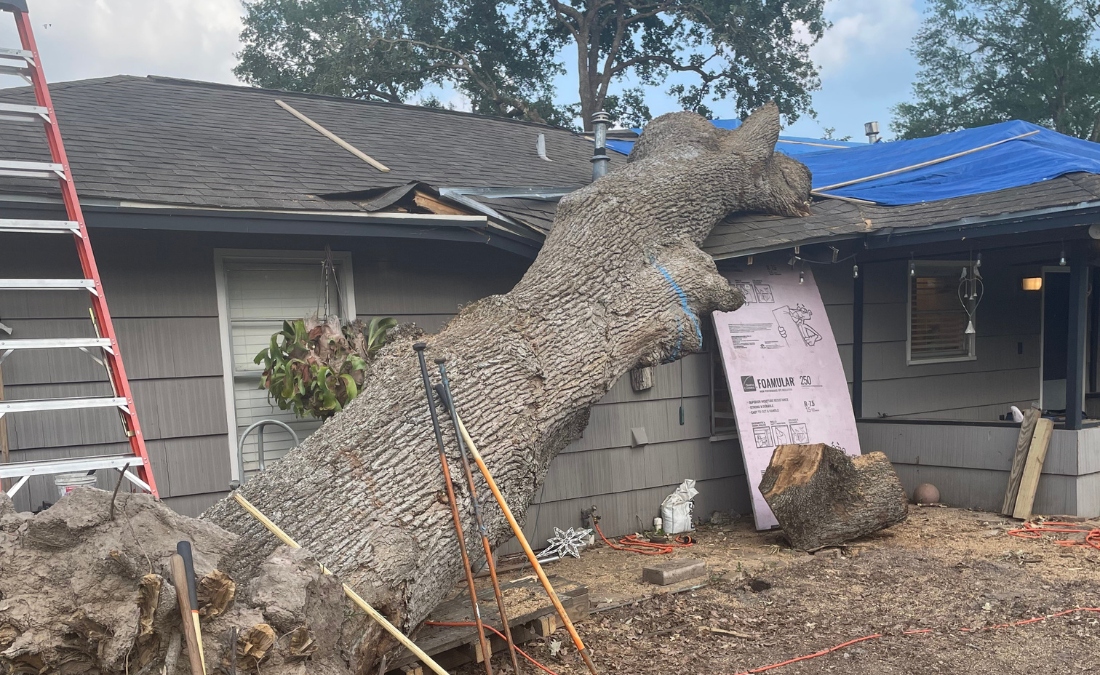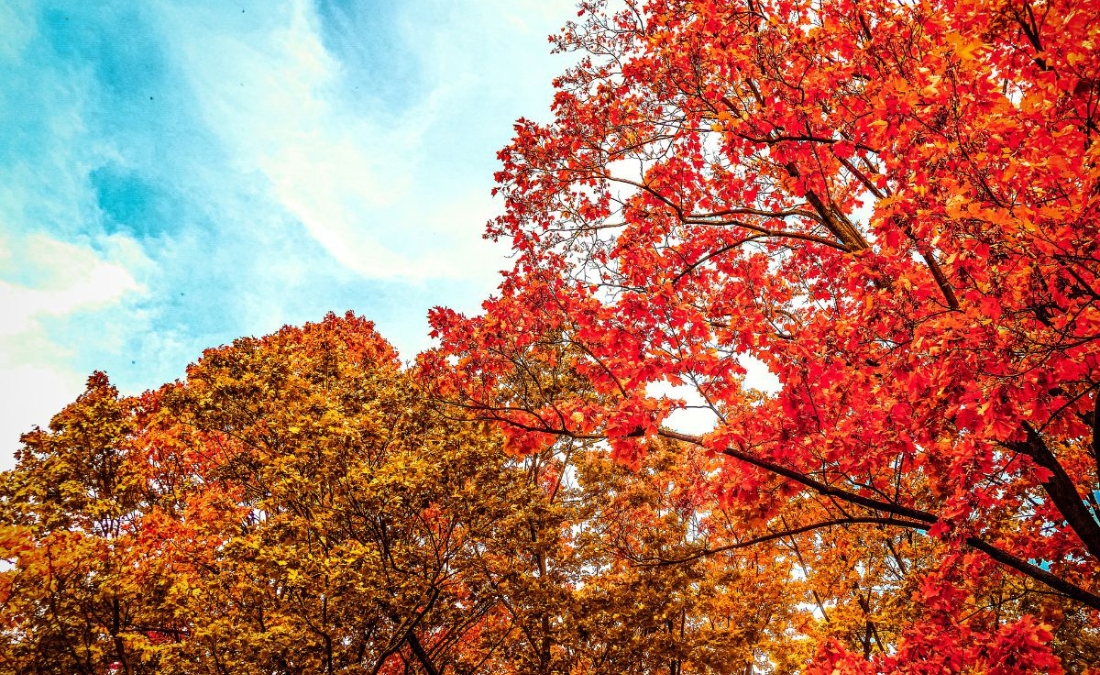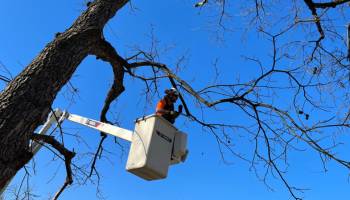How to Inspect Your Trees After a Storm to Find Hidden Damage
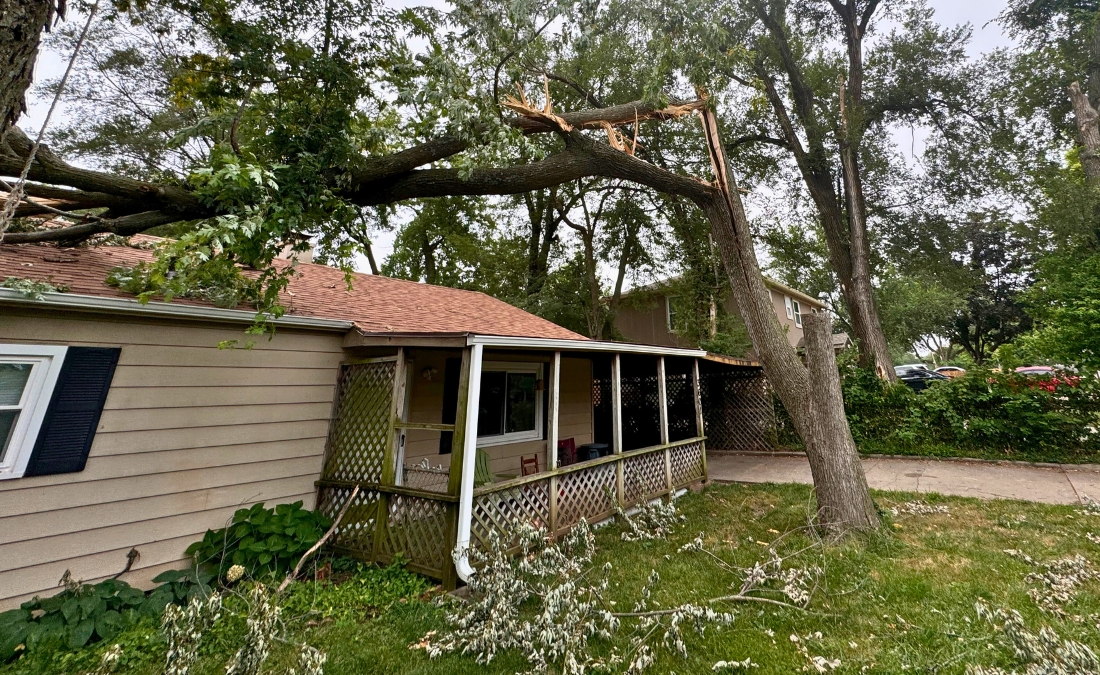
After a Wichita storm, tree damage isn’t always obvious. Discover how to inspect your trees safely and when to call Arbor Masters’ ISA Certified Arborists.
When Wichita experienced a record-tying 101 mph wind gust on June 17, 2025, homeowners across Andover, Derby, and Goddard woke up to a landscape forever changed. Trees that had weathered decades of Kansas storms suddenly showed signs of serious damage. Some fell completely, while others appeared fine but harbored hidden injuries that could prove dangerous months later.
The truth is, not all storm damage is immediately obvious. A tree might look healthy from your kitchen window, yet have critical structural problems that make it a ticking time bomb. That’s why knowing how to properly inspect your trees after severe weather can protect you and your family from injuries and property damage.
Key Takeaways
- Stay at least 25 feet away from downed power lines and never attempt to remove large hanging branches yourself.
- Look carefully for vertical cracks, splits, or missing bark that could indicate the tree won’t survive.
- Broken and partially attached branches are unstable and pose ongoing risks to people and property below.
- Root damage and new leaning may not be immediately visible, but even slight changes in a tree’s angle can signal dangerously compromised root systems.
- Trees with significant trunk damage, large hanging branches, or contact with power lines require expert evaluation and treatment.
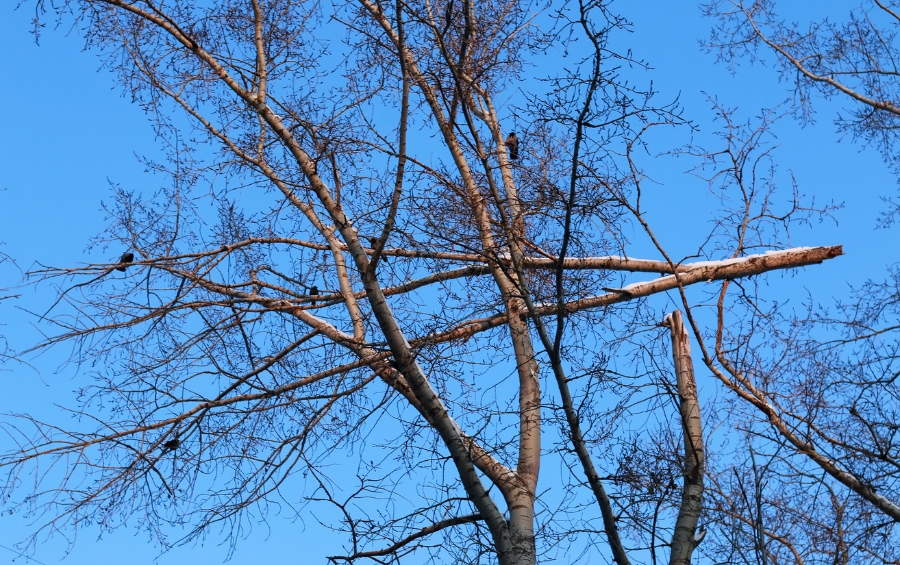
Broken branches high in the canopy require professional assessment and removal for safety.
Start with Safety
Storms don’t just knock down branches – they leave behind hidden dangers that can put you and your family at serious risk. Before you even think about inspecting your trees, take a few minutes to scan your property for immediate hazards.
The most urgent threat is downed power lines. They can stay live for hours or even days, and you won’t always be able to tell by looking. Always maintain a distance of at least 25 feet from any downed power lines, and call 911 immediately if you see wires touching trees or lying on the ground. According to the Electrical Safety Foundation International, contact with power lines causes an average of 62 deaths per year in the United States. Even if a line appears dead, treat it as if it’s carrying full electrical current.
SAFETY WARNING: Never attempt to move downed power lines or touch anything they’re in contact with, including trees, fences, or water. Even experienced tree professionals wait for utility crews to declare lines safe before beginning work.
But power lines aren’t the only danger. Other signs of storm damage can be just as serious and deserve the same level of caution:
- Wires touching tree branches or trunks
- Large branches hanging overhead in “widow maker” positions
- Trees leaning significantly more than before the storm
- Cracks in the ground around tree bases, indicating root failure
If you spot any of these conditions, keep everyone away from the area and call our emergency tree service professionals immediately. Your safety is worth more than any tree.
Inspect Your Tree’s Trunk for Critical Damage
The trunk is your tree’s backbone, and damage here often determines whether a tree can be saved. Start by walking slowly around each tree, looking carefully at the bark from ground level up to the first major branches.
“In my many years working with storm-damaged trees in Wichita, I’ve learned that trunk damage tells the whole story. A tree can lose half its branches and recover beautifully, but serious trunk injuries usually mean we’re looking at removal for safety reasons.” – DJ Waters, Branch Manager and ISA Certified Arborist at Arbor Masters
Watch for these critical warning signs:
- Vertical Cracks or Splits: The most serious type of trunk damage, which often appears as lightning-bolt-shaped fissures running up and down the trunk. Unlike horizontal wounds that trees can often heal, vertical splits compromise the tree’s structural integrity.
- Missing Bark Sections: This type of damage exposes the tree’s vital cambium layer underneath. According to the International Society of Arboriculture, the tree won’t survive if more than one-third of the bark is missing around the trunk’s circumference. Look especially carefully at areas where branches meet the trunk, as these junction points take tremendous stress during high winds.
- New Cavities or Exposed Decay: Storms often peel back bark and reveal hidden problems. You might suddenly see dark, hollow areas or fungal growth that wasn’t apparent before. These indicate internal weakness that makes the tree much more likely to fail in future storms. In some cases, this type of damage can also indicate underlying root rot issues that compromise the entire tree’s stability.
Pay special attention to trees that have already suffered previous damage from construction, storms, or pest activity. Storm winds often exploit these existing weak points.
Check Branches Throughout the Tree Canopy
Broken branches create some of the most dangerous situations after storms. The June 2025 winds that hammered Wichita created thousands of these “hanging hazards,” which appear stable but can drop without warning.
Use binoculars or carefully position yourself at different angles around the tree to inspect the crown. Look for:
- Partially Broken Branches: Pieces still hanging by bark strips or thin wood fibers are unstable and can fall suddenly.
- New Contact Points: Branches that shifted during the storm may now be touching power lines, your roof, or other structures.
- Overall Canopy Loss: If more than 50% of the major branches are lost, the tree has a significantly lower chance of survival.
During the March 2025 windstorm, homeowners in Derby reported 3-inch diameter branches scattered across yards. While losing smaller branches is actually the tree’s natural way of protecting itself, larger branch failures often indicate more serious structural problems.
Watch for Root and Foundation Problems
Root damage is often the hardest type of storm injury to spot, but it can be the most dangerous. Trees with compromised root systems may appear healthy for weeks or months before suddenly failing during the next severe weather event.
Walk around the base of each tree and look for these warning signs:
- Soil Heaving or Mounding: This indicates that roots have been torn or shifted underground. You might see small cracks in the soil radiating out from the trunk, or areas where the ground appears pushed up or sunken down compared to before the storm.
- Exposed Roots: Roots may become visible after heavy rains wash away soil or when strong winds rock the tree back and forth. Any major root that’s thicker than your arm and newly exposed should be cause for concern.
- New Leaning or Tilting: If a tree that was previously straight now leans noticeably in any direction, its root system has likely been compromised. This is especially common in Wichita’s clay soils, which become very soft when saturated and provide less root anchoring.
Trees in areas like Goddard and Maize, where newer developments have disturbed natural soil patterns, face additional risks. Construction activities that happened years ago can create underground weak spots that storm winds finally exploit. When root damage occurs, proper evaluation and potential structural support through cabling and bracing may be necessary to prevent future failure.
Pay Attention to Hidden Damage That Shows Up Later
Some of the most dangerous tree damage doesn’t appear immediately after storms. Some of the most dangerous problems take weeks or even months to reveal themselves:
- Delayed Stress Cracks: Trees often develop new splits in their trunks or limbs as they attempt to adjust to new weight distribution after losing major branches.
- Disease and Pest Entry: Broken bark and torn branches create easy access points for fungi, bacteria, and insects.
- Internal Injuries: What looks like minor bark damage can mask deeper structural issues that make a tree more likely to fail later.
This is why we always recommend having trees professionally inspected within two weeks of major wind events, like Wichita experienced in June 2025. Early intervention can often save trees that would otherwise decline over the following months.

Certified Arborists use specialized techniques to identify hidden structural problems in storm-damaged trees.
When to Call Arbor Masters vs. DIY Fixes
While homeowners can safely assess many aspects of storm damage, certain situations absolutely require professional expertise. Here’s how to know when to call our ISA Certified Arborists:
Call professionals immediately for:
- Any tree or branch touching power lines
- Large hanging branches over houses, driveways, or walkways
- Trees leaning toward structures or leaning more than 15 degrees from vertical
- Major trunk cracks or splits
- Trees that have fallen but not completely uprooted
What you can often handle yourself is:
- Picking up small branches and debris from the ground
- Removing broken branches smaller than 2 inches in diameter (though proper timing matters – learn about when pruning is most beneficial for your trees)
- Documenting damage with photos for insurance purposes
- Watering trees to help with stress recovery
At Arbor Masters, our TCIA Accreditation and ISA Certified Arborists mean you’re getting the highest level of professional tree care available in Wichita. We’ve been helping local homeowners save their trees since 1960, and we understand how much these living assets mean to your family.
Our emergency response teams can usually reach anywhere in our service area within 24-48 hours, even during busy periods after major storms. We carry full insurance and use equipment specifically designed for safe tree work around homes and power lines.
REMEMBER: Insurance typically covers storm damage to your home, but not preventable damage from trees you knew were compromised. A professional inspection after every major storm isn’t just about tree health – it’s about protecting your family and your financial investment.
Frequently Asked Questions
How long after a storm should I inspect my trees?
Inspect your trees as soon as it’s safe to go outside, typically within 24-48 hours after the storm passes. However, some damage becomes more apparent over the following weeks, so plan on a second inspection about two weeks later. The sooner you identify problems, the more options you’ll have for treatment.
What if my tree looks fine, but my neighbors’ trees are damaged?
Don’t assume your trees escaped unharmed just because they look good from a distance. Storm winds can be very localized, and trees that appear undamaged often have hidden injuries. Even if your trees seem fine, it’s worth having them inspected by a professional after major wind events like Wichita’s recent storms.
Can small cracks in bark heal on their own?
Small surface cracks in bark can often heal naturally if they don’t penetrate deeply into the tree’s cambium layer. However, any crack longer than 12 inches or deeper than the bark thickness should be evaluated by an arborist. Trees have remarkable healing abilities, but they need help with larger wounds.
How do I know if my tree will survive storm damage?
Trees are remarkably resilient, but survival depends on the extent and location of damage. Trees can generally recover from losing up to 50% of their branches, but trunk damage is much more serious. The tree’s overall health before the storm also plays a major role in recovery potential.
What’s included in a professional tree risk assessment?
Our ISA Certified Arborists examine the entire tree system, including roots, trunk, branches, and crown. We look for structural defects, disease signs, pest damage, and environmental stressors. You’ll receive a detailed report with recommendations for treatment, monitoring, or removal, along with priority levels for any needed work.
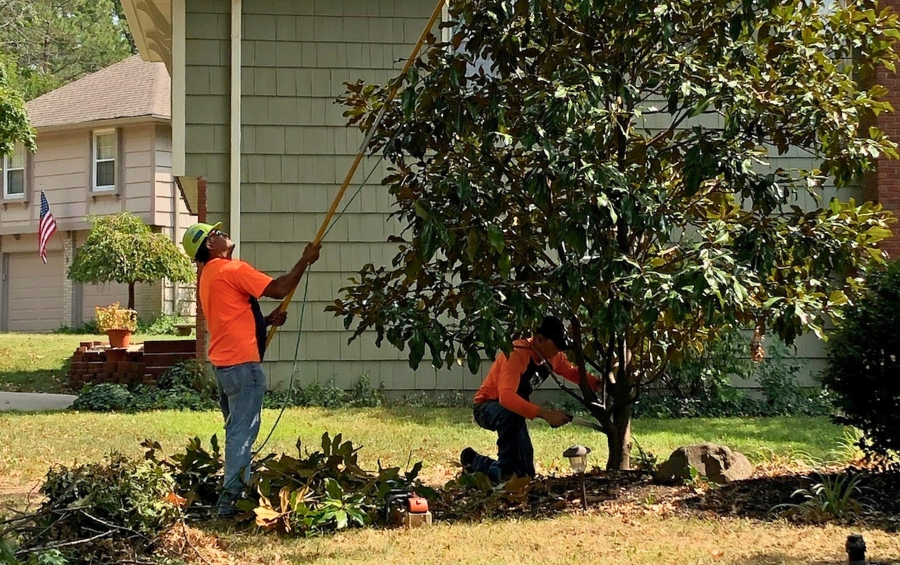
Professional cleanup crews can safely assess and remove storm-damaged trees and debris.
Don’t Wait for Hidden Damage to Become a Disaster – Call Arbor Masters
Assessing storm damage after severe weather isn’t just about saving trees – it’s about protecting your family and property. A tree that looks fine today could become dangerous during the next windstorm if hidden damage goes unaddressed.
At Arbor Masters, our “Trees Trust Us” philosophy means we focus on preservation whenever possible. With 65+ years of experience serving Wichita, we know your trees are valuable investments that provide shade, beauty, and environmental benefits for decades. Our ISA Certified Arborists can identify problems early and often save trees that other companies might recommend removing.
Call Arbor Masters at (316) 838-3111 today for expert tree inspection and storm damage assessment throughout Andover, Derby, Goddard, Valley Center, and the entire Wichita area.

Get the latest local news, tree care tips, special offers, and company updates directly to your inbox! It's easy to subscribe and there's no spam - we promise.
"*" indicates required fields



